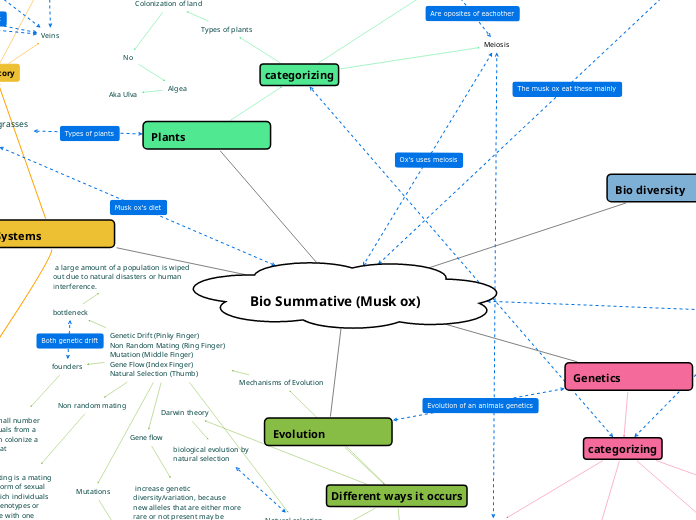Bio Summative (Musk ox)
Systems
Ciculatory
Blood
Red blood cells
contain proteins called hemoglobin that allow
them to pick up oxygen and carbon dioxide
White blood cells
Fight disease-causing bacteria and viruses
Platelet
A cell fragment that helps the blot clot, seal
wounds and stop bleeding
When a blood vessel is broken, platelets will
stick together to seal the hole so the vessel can
rebuild
Plasma
Protein-rich liquid in which blood cells are
suspended
Carries a number of dissolved ions such as Na+,
K+, and Ca2+
Arteries
Veins
Heart
parts of heart
Vena cava
Superior vena cava
Inferior vena cava
atriums
septum
ventricles
valves
Semilunar Valve
Atrioventricular Valves
Semilunar Valve
pulmonary
2 pulmonary vens
2 pulmonary arteries
Aorta
Digestive
GI track
Mouth
physically breaks down food
Small intestine
Sections
Duodenum (first section)
Ileum (third/final section)
Jejunum (second section)
Large intestine
Stomach
Both mechanical and chemical digestion occur
Esophagus
Transports food from the mouth to the stomach
using a process called peristalsis to move food
Accessory Organs
Salivary glands
Makes saliva to break down food
Gall bladder
Stores Bile that was produced by liver
Pancrease
produces enzymes that help to digest food, particularly protein. The endocrine pancreas makes the hormone insulin, which helps to control blood sugar levels.
Liver
filters all of the blood in the body and breaks down poisonous substances,
Respatory
lungs
Nose
Mouth
Epiglottis
Bronchi
Bronchioles
Diseases
asthma, chronic obstructive pulmonary disease (COPD), lung cancer, cystic fibrosis, sleep apnea and occupational lung diseases
Alveoli
Trachea
Diaphragm
Larynx
Pharynx
Evolution
Different ways it occurs
Mechanisms of Evolution
Genetic Drift (Pinky Finger)
Non Random Mating (Ring Finger)
Mutation (Middle Finger)
Gene Flow (Index Finger)
Natural Selection (Thumb)
bottleneck
founders
Non random mating
Mutations
it generates the genetic variation on which the evolutionary process depends.
Gene flow
Natural selection
Darwin theory
Gene pools
Evedince
Fossils
Bones of dead animals
Artificial selection
Biogeography
DNA
Comparative anatomy
Embryology
Bio diversity
categorizing + Taxonomy
Domains
Prokaryote
Kindoms
Archea
Bacteria
Eukaryote
Kingdoms
Animalia
Phylums
Chordate
Fungi
Plantae
Protists
life, domain, kingdom, phylum, clss, order, family, genus, species
Genetics
categorizing
Traits
Dominant
Recessive
DNA
Blood type
AA, Aa, BB, Bb AB, O
Mitosis vs meiosis
Mitosis
4 phases
2 cells created
new cells are somatic daughters
Makes diploid cells
Meiosis
Crossing over occurs
8 phases
4 new cells
New cells are haploid
New cells are gametes
Chromosomes
Non disjunction
failure of a pair of homologous chromosomes to separate in meiosis I, failure of sister chromatids to separate during meiosis II, and failure of sister chromatids to separate during mitosis.
X and Y
Plants
categorizing
Meiosis
meitosis
Types of plants
Colonization of land
No
Algea
Aka Ulva
Yes
vascular
Yes
Is it a seed plant
Yes
Is it flowering
No
Gymnosperm
Aka conifers
yes
Angiosperm
Aka flowering plant
No
Pteridophytes
Aka ferns
No
Bryophytes
Aka mosses
